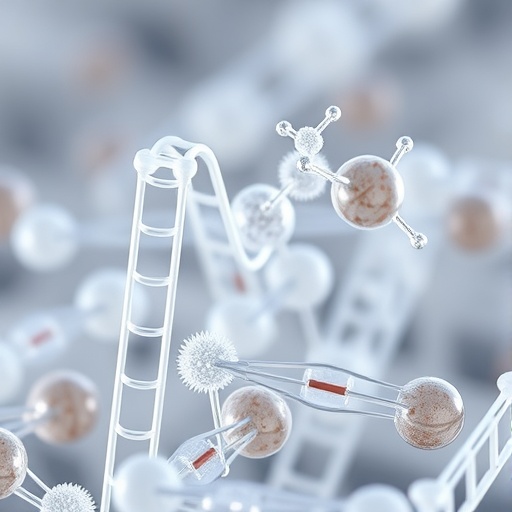In an era increasingly scrutinized for the pervasive presence of microplastics and nanoplastics in our environment, groundbreaking research sheds new light on the toxicity these tiny particles may pose to human health—specifically, the respiratory system. A recent study led by Gosselink, Leonhardt, Höppener, and colleagues meticulously investigates how different sizes and types of amorphous micro- and nanoplastics affect human bronchial epithelial cells, the very cells lining our lung airways. The findings emerge from a comprehensive exploration published in Microplastics and Nanoplastics, revealing nuanced risks associated with these omnipresent pollutants.
Microplastics and nanoplastics—particles smaller than 5 millimeters down to the nanoscale—have infiltrated ecosystems worldwide, from ocean depths to the very air we breathe. These polymers, once thought mostly inert, have gained infamy for their potential to inflict cellular damage, provoke inflammation, and disrupt biological functions. Yet, detailed insights into how particle size and polymer composition influence their toxicity remain scarce. This study fills a vital gap by simulating real-world exposure scenarios in human bronchial cells, which are frontline defenders against airborne contaminants.
Employing amorphous micro- and nanoplastics that reflect environmental relevancy, the researchers exposed cultured human bronchial epithelial cells to particles differentiated by size and polymer type. This nuanced approach acknowledges that not all plastics behave identically in biological systems—polypropylene, polyethylene, and polystyrene may vary widely in their interaction with cell membranes and intracellular processes. By scrutinizing these variables, the team dissected how physicochemical properties translate into cellular responses.
The results unveiled a striking size-dependent toxicity gradient. Nanoplastics demonstrated a profoundly greater capacity to penetrate cells and instigate cytotoxic effects compared to microplastic counterparts. This enhanced toxicity stems largely from their diminutive size, which facilitates cellular uptake via endocytosis and escalates oxidative stress. Once internalized, nanoplastics impair mitochondrial function, disrupt membrane integrity, and trigger inflammatory signaling pathways. Such mechanisms collectively undermine epithelial barrier function, critical for lung health.
Moreover, the polymer type emerged as a pivotal factor modulating toxicity profiles. Polystyrene nanoplastics were especially notorious for inducing elevated reactive oxygen species (ROS) generation and pro-inflammatory cytokine release. Meanwhile, polyethylene particles elicited milder responses, suggesting inherent polymer chemistry influences biological interactions. This variability underscores the complexity of micro- and nanoplastic pollution, demanding polymer-specific risk assessments rather than blanket assumptions about their hazard potential.
The study’s incorporation of environmentally relevant particles marks a significant advance beyond many prior investigations reliant on pristine, spherical laboratory-generated plastics. Real-world plastics, often fragmented, irregular, and coated with environmental biomolecules, interact differently with human tissues. By replicating such conditions, the research better predicts genuine pathophysiological outcomes, enhancing its ecological validity and public health ramifications.
Central to the investigation’s methodology was leveraging advanced imaging and biochemical assays that quantified cellular viability, oxidative stress markers, inflammatory mediators, and ultrastructural alterations. Confocal microscopy vividly captured the internalization of nanoplastics within epithelial cells, while quantitative assays revealed dose-dependent declines in mitochondrial function and increases in pro-inflammatory gene expression. These converging lines of evidence affirm a mechanistic link between size- and polymer-dependent properties of plastics and bronchial epithelial toxicity.
The findings carry profound implications for understanding respiratory health risks posed by airborne micro- and nanoplastics. Inhalation represents a major human exposure route, especially in urban and industrial contexts where plastic pollution is rampant. Compromised epithelial barrier integrity due to particle toxicity could exacerbate susceptibility to respiratory diseases such as asthma, chronic obstructive pulmonary disease (COPD), and infections. Furthermore, chronic inflammation triggered by persistent cellular stress may lay the groundwork for long-term pulmonary pathology.
Beyond health, this research spotlights urgent needs for regulatory frameworks that integrate nanoscale plastic hazards and their compositional diversity. Present standards often overlook particle size nuances and polymer-specific effects, leading to underestimation of risk. A safer plastics economy demands comprehensive hazard characterization guiding production, use, and disposal to minimize human exposure to the most detrimental forms of micro- and nanoplastic pollution.
In addition to human health, environmental implications ripple outward. Bronchial epithelial cells serve as a cellular proxy for other vulnerable organisms exposed to airborne plastics. The observed toxicological mechanisms could inform broader ecotoxicology paradigms—encouraging multidisciplinary efforts to mitigate microplastic harms in atmospheric ecosystems. Moreover, identifying polymer-specific biomarkers of toxicity opens avenues for molecular-level intervention strategies and diagnostic tools.
This pioneering study also inspires pressing questions for future research. How do chronic low-dose exposures reshape epithelial cell phenotype and function over time? Can antioxidants or pharmacological agents ameliorate plastic-induced oxidative and inflammatory damage? What roles do protein corona formations on micro- and nanoplastics play in modulating their cellular interaction and toxicity? Such inquiries are crucial to translate foundational knowledge into tangible public health protections.
Finally, the research underscores an urgent clarion call to reduce plastic pollution at the source. While scientific revelations elucidate risks at the cellular scale, curbing global plastic production, improving waste management, and advancing biodegradable alternatives are paramount decisions society must embrace. Only through integrated efforts spanning molecular toxicology, environmental stewardship, and policy innovation can the escalating threat of micro- and nanoplastics be effectively addressed.
Overall, this landmark investigation redefines our understanding of micro- and nanoplastic hazards in the human respiratory system. The revelation that size and polymer composition jointly dictate cellular outcomes revolutionizes risk assessment paradigms, emphasizing the necessity for nuanced, multifactorial scrutiny. As these tiny particles continue to infiltrate the lungs of billions, research like this illuminates pathways toward safeguarding respiratory health in an increasingly plastic-laden world.
Subject of Research: Toxicity of environmentally relevant micro- and nanoplastics on human bronchial epithelial cells, focusing on size- and polymer-dependent effects.
Article Title: Size- and polymer-dependent toxicity of amorphous environmentally relevant micro- and nanoplastics in human bronchial epithelial cells
Article References:
Gosselink, I.F., Leonhardt, P., Höppener, E.M. et al. Size- and polymer-dependent toxicity of amorphous environmentally relevant micro- and nanoplastics in human bronchial epithelial cells. Micropl.& Nanopl. 5, 19 (2025). https://doi.org/10.1186/s43591-025-00126-9
Image Credits: AI Generated




